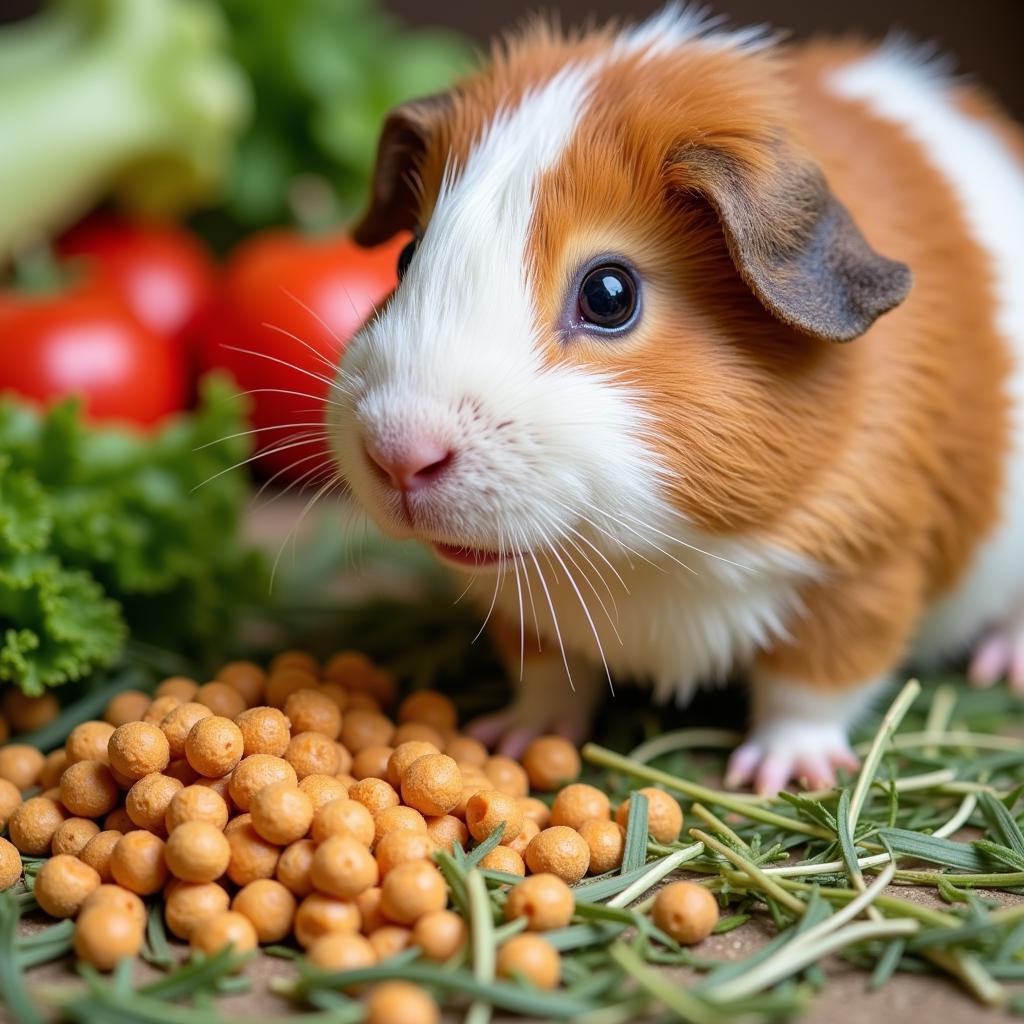Creating Homemade Guinea Pig Food can be a rewarding experience, ensuring your furry friend receives the optimal nutrition they need. This guide will delve into the essential aspects of preparing balanced and delicious meals for your guinea pigs, ensuring their long-term health and happiness.
Why Make Homemade Guinea Pig Food?
Choosing to prepare homemade guinea pig food allows you to control the quality and freshness of the ingredients. You can avoid the fillers, preservatives, and artificial colors often found in commercial pellets, giving your cavy the best possible diet. Plus, it’s a fun way to bond with your pet!
Essential Nutrients for Guinea Pigs
Just like us, guinea pigs need a balanced diet to thrive. Their nutritional needs include a constant supply of vitamin C, as they cannot produce it themselves. Hay is the cornerstone of their diet, providing crucial fiber for digestive health. Fresh vegetables and a small amount of pellets contribute additional vitamins and minerals.
- Vitamin C: Essential for immune function and overall health.
- Fiber: Crucial for digestive health and preventing dental problems.
- Vitamins and Minerals: Support various bodily functions.
The Dangers of a Poor Diet
An unbalanced diet can lead to serious health issues for your guinea pig, including scurvy (vitamin C deficiency), digestive problems, and obesity. Providing a diet rich in hay and fresh vegetables is crucial for preventing these problems and ensuring your pet lives a long, healthy life.
Creating a Balanced Homemade Meal Plan for Your Guinea Pig
A healthy homemade guinea pig food plan should primarily consist of high-quality hay, supplemented with fresh vegetables and a small portion of fortified pellets. This combination ensures your cavy receives all the necessary nutrients to maintain optimal health.
Hay is King: The Foundation of Your Guinea Pig’s Diet
Unlimited access to fresh, high-quality grass hay, such as Timothy hay, is essential for guinea pigs. Hay provides the fiber they need for proper digestion and helps keep their teeth healthy. Avoid alfalfa hay, as it is too high in calcium for adult guinea pigs.
Veggies: Adding Variety and Vitamins
Offer a variety of fresh vegetables daily. Leafy greens like romaine lettuce, kale, and spinach are excellent choices. Other vegetables, like bell peppers, carrots, and cucumbers, can be offered in moderation. Always wash vegetables thoroughly before serving.
 A guinea pig enjoying a homemade meal
A guinea pig enjoying a homemade meal
Pellets: A Supplement, Not the Main Course
Choose high-quality pellets specifically formulated for guinea pigs. Avoid pellets with added sugars, seeds, or nuts. Pellets should only make up a small portion of their daily diet.
Recipes for Homemade Guinea Pig Treats
While hay and vegetables should make up the majority of your guinea pig’s diet, occasional homemade treats can be a fun and healthy way to add variety.
Parsley and Carrot Nibblers
Combine finely chopped parsley and grated carrots to create small, bite-sized treats. These are a great source of vitamins A and C.
Cucumber and Bell Pepper Slices
Cut thin slices of cucumber and bell pepper. These refreshing treats are perfect for hot days and are a good source of hydration.
“Fresh, quality ingredients are key to a happy and healthy guinea pig,” says Dr. Amelia Harper, DVM, specializing in exotic animal care. “Homemade food allows owners to provide optimal nutrition while avoiding unnecessary additives.”
What to Avoid Feeding Your Guinea Pig
Certain foods are toxic to guinea pigs and should never be given to them. These include chocolate, avocado, onions, garlic, and rhubarb. Always research any new food before introducing it to your guinea pig’s diet.
Conclusion
Preparing homemade guinea pig food offers a fantastic way to ensure your furry companion receives optimal nutrition, leading to a healthier and happier life. By following this guide and incorporating fresh, high-quality ingredients, you’re setting your guinea pig up for success! Remember to consult with your veterinarian if you have any questions about your guinea pig’s diet.
FAQ
- How much hay should I give my guinea pig? Unlimited access to fresh hay.
- Can guinea pigs eat fruit? Yes, in small quantities as treats.
- What are the signs of vitamin C deficiency in guinea pigs? Lethargy, loss of appetite, and joint pain.
- How often should I clean my guinea pig’s cage? At least once a week.
- What type of bedding is best for guinea pigs? Fleece, paper bedding, or aspen shavings.
- Can guinea pigs eat iceberg lettuce? No, it has little nutritional value and can cause diarrhea.
- How can I introduce new foods to my guinea pig’s diet? Gradually, over several days.
“Providing a variety of fresh vegetables, along with unlimited hay, is crucial for a guinea pig’s digestive health,” adds Dr. Harper. “This mimics their natural diet and helps prevent common health problems.”
Do you have more questions regarding your guinea pig’s nutrition or care? Explore other helpful articles on our website, such as “Understanding Your Guinea Pig’s Dietary Needs” and “Creating a Stimulating Environment for Your Cavy.”
When you need support, please contact Phone Number: 02437655121, Email: minacones@gmail.com Or visit our address: 3PGH+8R9, ĐT70A, thôn Trung, Bắc Từ Liêm, Hà Nội, Việt Nam. We have a 24/7 customer service team.